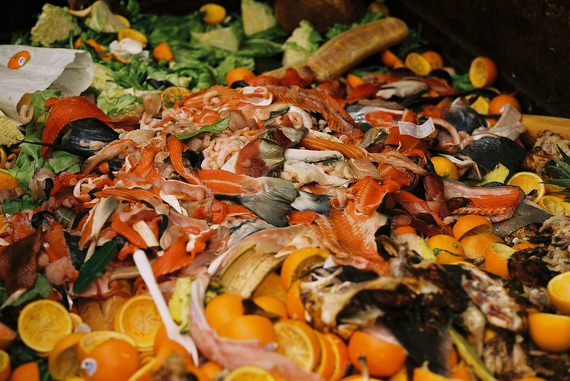The amount of food we waste is enough to make you sick... many times over.
The latest installment [pdf] in the World Bank's "Food Price Watch" series has just been released. If you're a consumer -- and when it comes to food, aren't we all -- there's some good news: food prices between October 2013 and January 2014 have continued the modest decline that began last summer.
But the report documents some disturbing data as well: the huge amounts of food lost and wasted each year -- especially by us North Americans. These data become downright unconscionable when you consider that, of the world's 7.15 billion people or so, more than 800 million are chronically hungry, and as for children under five, in 2012, 162 million were stunted and 99 million were underweight. (Sources: UNICEF, World Health Organization, the World Bank [pdf])
Some Hard-to-Swallow Food Statistics to Digest:
Global Data
Amount of food produced globally per year: ~4 billion tons
Amount of food lost or wasted per year: ~1.3 billion tons (Source: UN Food and Agriculture Organization [pdf])
Percentage of global food produced that is lost or wasted (by energy): ~24 percent (Source: World Resources Institute)
Or, to borrow a passage from the WRI report, "Essentially, people fail to consume one quarter of all calories produced for them."
Food Stats From the Developing World
Percentage of the globally produced food lost or wasted in the developing world: 44 percent
Per capita food lost or wasted per year: 120-220 kilograms
The largest losses and waste occur in the production, handling and storage stages of the food system.
Food Stats From the Developed World
Percentage of the globally produced food lost or wasted in the developed world: 56 percent
Per capita food lost or wasted per year: 250-300 kilograms
Per capita food lost or wasted per year by consumers after purchase: 75-115 kilograms
Percentage of food loss and waste per year in North America that is caused by the consumer: 25 percent
In Europe and industrialized Asia about 50 percent of all losses and waste of food occur at the consumer level. In North America that percentage rises to 60 percent. That's right, folks, more than half of all food lost and wasted in the United States is caused by our own carelessness -- for example by allowing food to rot in the refrigerator, or should I say your refrigerator.
Dollars squandered by a family of four in the United States because of food loss and waste: $1,600 per year
Here's a frightening statistic. The U.S. Environmental Protection Agency reports that, in the world of municipal solid waste, food is No. 1; it is found more "than any other single material in municipal solid waste ... [with] more than 36 million tons of food waste ... generated" in 2012 alone.
Energy Inefficiency
... in a developing country: 400-600
... in Europe: 748
... in industrialized Asia: 746
... in the United States, Canada, Australia and New Zealand: 1,520
That's what's wasted.
This Is What's Needed on Average
Minimum caloric intake: 1,800
This Is What's Eaten on Average
... in developing countries: 2,850
... in developed countries: 3,440 (Source: WHO)
Average Food Deficit
... Sub-Saharan Africa: 160-490
... Latin American: 140-460
... Europe: 110-150
... United States: 140
__________________________________
End Notes
The World Bank defines food loss and waste as the "edible parts of plants and animals intended for human consumption that are not ultimately consumed by people."↩
Data from World Bank report unless otherwise noted.↩
Developing countries are those in North Africa, west and central Asia, Latin America, south and southeast Asia, Sub-Saharan Africa.↩
Developed countries are those in industrialized Asia, North America and Oceania, Europe.↩
"The diversity in body size, body composition and habitual physical activity among adult populations with different geographic, cultural and economic backgrounds does not allow a universal application of energy requirements." (Source: UN FAO)↩
Keep up with TheGreenGrok | Find us on Facebook
